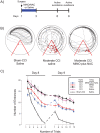Minocycline synergizes with N-acetylcysteine and improves cognition and memory following traumatic brain injury in rats
- PMID: 20824218
- PMCID: PMC2930858
- DOI: 10.1371/journal.pone.0012490
Minocycline synergizes with N-acetylcysteine and improves cognition and memory following traumatic brain injury in rats
Abstract
Background: There are no drugs presently available to treat traumatic brain injury (TBI). A variety of single drugs have failed clinical trials suggesting a role for drug combinations. Drug combinations acting synergistically often provide the greatest combination of potency and safety. The drugs examined (minocycline (MINO), N-acetylcysteine (NAC), simvastatin, cyclosporine A, and progesterone) had FDA-approval for uses other than TBI and limited brain injury in experimental TBI models.
Methodology/principal findings: Drugs were dosed one hour after injury using the controlled cortical impact (CCI) TBI model in adult rats. One week later, drugs were tested for efficacy and drug combinations tested for synergy on a hierarchy of behavioral tests that included active place avoidance testing. As monotherapy, only MINO improved acquisition of the massed version of active place avoidance that required memory lasting less than two hours. MINO-treated animals, however, were impaired during the spaced version of the same avoidance task that required 24-hour memory retention. Co-administration of NAC with MINO synergistically improved spaced learning. Examination of brain histology 2 weeks after injury suggested that MINO plus NAC preserved white, but not grey matter, since lesion volume was unaffected, yet myelin loss was attenuated. When dosed 3 hours before injury, MINO plus NAC as single drugs had no effect on interleukin-1 formation; together they synergistically lowered interleukin-1 levels. This effect on interleukin-1 was not observed when the drugs were dosed one hour after injury.
Conclusions/significance: These observations suggest a potentially valuable role for MINO plus NAC to treat TBI.
Conflict of interest statement
Figures





References
-
- Moreno S, Lopez Aldeguer J, Arribas JR, Domingo P, Iribarren JA, et al. The future of antiretroviral therapy: challenges and needs. J Antimicrob Chemother. 2010;65:827–835. - PubMed
-
- White WB. Hypertension: antihypertensive class matters for combination therapy. Nat Rev Cardiol. 2010;7:303–304. - PubMed
Publication types
MeSH terms
Substances
LinkOut - more resources
Full Text Sources
Medical
Research Materials

